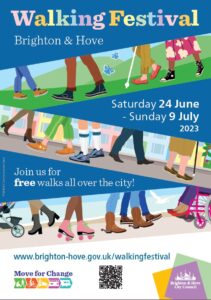
The Brighton & Hove Walking Festival is a two-week celebration of being in the great outdoors. We hope it inspires you to discover the numerous trails and footpaths throughout the City, and feel the benefits of being out in the fresh air, doing the most natural exercise known to mankind. To help you on your way, we’ve put together the following ideas.
Before
· Ask the children what they like about walking and talk about its benefits
· Ask the children where they like to walk the most (in the City and elsewhere) and create a wall chart of their favourite walks on the Brighton & Hove Green Spaces map (see Resources)
· Talk about the memorable walks the children have done with families and friends
· Talk about famous explorers & walkers and consider importance of walking throughout history and in different cultures.
On route
Track fitness
· (for the teacher) Count the steps using your phone/FitBit etc. and then multiply the steps to get the count for the whole group. All the totals can then be combined to generate a whole school walking festival step count
· Measure your pulse throughout the walk, along the flat, and up the hills.
Enhance your map reading skills
· Give students a map to navigate
· Draw a map of your route and the landmarks as you pass them
· Use a compass to record the direction you’re going
· Use natural materials to create a map of your route.
Record and collect
· Take a camera or phone to photograph things along the way, and use them to make a storyboard to display back in class
· Take photos along the route of specific themes e.g. shapes, distance, weather, colours
· Create a scavenger hunt to complete along the way. You could include things to identify (buildings, wildlife, birds, trees), sounds (birds, traffic etc.) or count
· Create a journey stick mapping tool. This is a stick with elastic bands or string you can use to collect items along your route or a card with double sided sticky tape attached, to record where you went on your journey
· Collect natural treasures to take back to school or discover how many tiny objects can be fitted something like a matchbox.
Observe wildlife
· Take binoculars, specimen pots and a spoon, or a white sheet for ‘tree shaking’
· Look for tracks and trails and signs of wildlife
- Use the ‘SEEK’ or ‘iNaturalist’ app to identify species along the route or the ‘Merlin’ app to identify birdsong.
Play games
· Play ‘I spy’ or create a walking ‘bingo’ and to talk about all the things you can see
· Dress up as explorers
· Create a treasure hunt
· Include a blindfold walk, with partners guiding each other by voice or touch
· Maybe stop somewhere for a picnic lunch/snack.
Afterwards
· Creative activities to record the walk, pupils’ feelings about the walk and what they discovered. We’d love to see any examples, which you can send to: [email protected]
· Encourage the children to ‘lead’ their families on the same walk after school or at the weekend
· Add up the total number of steps for the group and add it to the school tally (including steps from your Walk to School week).
Resources
1. Walking risk assessments (Walking in open country risk assessment and Walking in town risk assessment)
2. Schools Green Spaces Jan 23
3. Tailored route service
If you’re not sure about what route to take from your school, just let us know the following and we will create a walk for you, starting and finishing at your school. Email: [email protected].
· Your year group
· How long you want to walk for/how far you want to go
· What type of walk you’d like to do (nature/historic building based/with a picnic stop etc.)
· Whether you have any children with mobility issues.
Link to the Walking Festival programme to share with families – www.brighton-hove.gov.uk/walkingfestival
Finally, let us know of any walks you undertake and how they go – enjoy!
